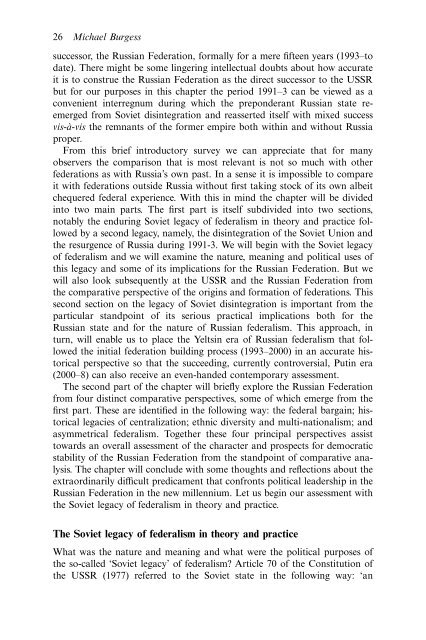Federalism and Local Politics in Russia
Federalism and Local Politics in Russia
Federalism and Local Politics in Russia
Create successful ePaper yourself
Turn your PDF publications into a flip-book with our unique Google optimized e-Paper software.
26 Michael Burgesssuccessor, the <strong>Russia</strong>n Federation, formally for a mere fifteen years (1993–todate). There might be some l<strong>in</strong>ger<strong>in</strong>g <strong>in</strong>tellectual doubts about how accurateit is to construe the <strong>Russia</strong>n Federation as the direct successor to the USSRbut for our purposes <strong>in</strong> this chapter the period 1991–3 can be viewed as aconvenient <strong>in</strong>terregnum dur<strong>in</strong>g which the preponderant <strong>Russia</strong>n state reemergedfrom Soviet dis<strong>in</strong>tegration <strong>and</strong> reasserted itself with mixed successvis-à-vis the remnants of the former empire both with<strong>in</strong> <strong>and</strong> without <strong>Russia</strong>proper.From this brief <strong>in</strong>troductory survey we can appreciate that for manyobservers the comparison that is most relevant is not so much with otherfederations as with <strong>Russia</strong>’s own past. In a sense it is impossible to compareit with federations outside <strong>Russia</strong> without first tak<strong>in</strong>g stock of its own albeitchequered federal experience. With this <strong>in</strong> m<strong>in</strong>d the chapter will be divided<strong>in</strong>to two ma<strong>in</strong> parts. The first part is itself subdivided <strong>in</strong>to two sections,notably the endur<strong>in</strong>g Soviet legacy of federalism <strong>in</strong> theory <strong>and</strong> practice followedby a second legacy, namely, the dis<strong>in</strong>tegration of the Soviet Union <strong>and</strong>the resurgence of <strong>Russia</strong> dur<strong>in</strong>g 1991-3. We will beg<strong>in</strong> with the Soviet legacyof federalism <strong>and</strong> we will exam<strong>in</strong>e the nature, mean<strong>in</strong>g <strong>and</strong> political uses ofthis legacy <strong>and</strong> some of its implications for the <strong>Russia</strong>n Federation. But wewill also look subsequently at the USSR <strong>and</strong> the <strong>Russia</strong>n Federation fromthe comparative perspective of the orig<strong>in</strong>s <strong>and</strong> formation of federations. Thissecond section on the legacy of Soviet dis<strong>in</strong>tegration is important from theparticular st<strong>and</strong>po<strong>in</strong>t of its serious practical implications both for the<strong>Russia</strong>n state <strong>and</strong> for the nature of <strong>Russia</strong>n federalism. This approach, <strong>in</strong>turn, will enable us to place the Yelts<strong>in</strong> era of <strong>Russia</strong>n federalism that followedthe <strong>in</strong>itial federation build<strong>in</strong>g process (1993–2000) <strong>in</strong> an accurate historicalperspective so that the succeed<strong>in</strong>g, currently controversial, Put<strong>in</strong> era(2000–8) can also receive an even-h<strong>and</strong>ed contemporary assessment.The second part of the chapter will briefly explore the <strong>Russia</strong>n Federationfrom four dist<strong>in</strong>ct comparative perspectives, some of which emerge from thefirst part. These are identified <strong>in</strong> the follow<strong>in</strong>g way: the federal barga<strong>in</strong>; historicallegacies of centralization; ethnic diversity <strong>and</strong> multi-nationalism; <strong>and</strong>asymmetrical federalism. Together these four pr<strong>in</strong>cipal perspectives assisttowards an overall assessment of the character <strong>and</strong> prospects for democraticstability of the <strong>Russia</strong>n Federation from the st<strong>and</strong>po<strong>in</strong>t of comparative analysis.The chapter will conclude with some thoughts <strong>and</strong> reflections about theextraord<strong>in</strong>arily difficult predicament that confronts political leadership <strong>in</strong> the<strong>Russia</strong>n Federation <strong>in</strong> the new millennium. Let us beg<strong>in</strong> our assessment withthe Soviet legacy of federalism <strong>in</strong> theory <strong>and</strong> practice.The Soviet legacy of federalism <strong>in</strong> theory <strong>and</strong> practiceWhat was the nature <strong>and</strong> mean<strong>in</strong>g <strong>and</strong> what were the political purposes ofthe so-called ‘Soviet legacy’ of federalism? Article 70 of the Constitution ofthe USSR (1977) referred to the Soviet state <strong>in</strong> the follow<strong>in</strong>g way: ‘an
















